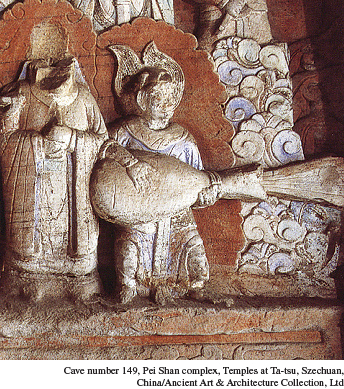Gunpowder

A twelfth-century Chinese Buddhist carving showing an early handheld gun.photo: Cave number 149, Pei Shan complex, Temples at Ta-tsu, Szechuan, China/Ancient Art & Architecture Collection, Ltd.
T he Chinese Tang and Song dynasties (618–1279) witnessed a golden age of technological innovation in China. Both woodblock and movable type generated the world’s first printed books, while Chinese innovations in navigational and shipbuilding technologies led the world. Among these many developments, the invention of gunpowder stands out because it spawned a permanent revolution in military affairs that had global dimensions. But gunpowder, a mixture of saltpeter, sulfur, and charcoal, was not originally developed for use in war. Instead, it was an accidental byproduct of the search by Daoist alchemists for an elixir of immortality. Indeed, the first reference to gunpowder appeared in a mid-ninth-century Daoist text that warns alchemists not to mix together its component parts because “smoke and flames result, so that [the alchemists’] hands and faces have been burnt, and even the whole house where they were working burned down.”8 This association with alchemy may explain why the Chinese referred to gunpowder as huo yao, or “fire drug.” The same properties that made gunpowder so dangerous in an alchemist’s lab attracted the interest of those seeking to entertain and amaze audiences through fireworks and pyrotechnic displays, especially at the Chinese imperial court.
Military authorities also noticed its potential as a weapon, and its uses in war developed rapidly during the Song dynasty. At first, military engineers drew on the incendiary rather than the explosive possibilities of gunpowder. In 1044, an imperial official wrote a tract for the emperor on military technologies that included two recipes for gunpowder, both for weapons designed to set fire to their targets. Decades later, Song engineers borrowed techniques from fireworks makers to produce “Thunderclap Bombs” designed to scare and disorient opposing troops through noise and light. While these bombs were not yet powerful enough to kill large numbers of the enemy, a chronicler of a siege of the Song capital in 1127 described them as “hitting the lines of the enemy well and throwing them into great confusion.”
Through the twelfth and early thirteenth centuries, both the Song dynasty, which controlled southern China, and the Jin, which controlled much of the north, continued to develop ever more powerful gunpowder weapons. Engineers experimented with gunpowder blends that included larger quantities of saltpeter, the nitrate-rich substance that gives gunpowder its explosiveness. When the Mongols invaded northern China in 1231, the defenders of the capital, Kaifeng, were able to deploy what they called the “Heaven-Shaking Thunder Crash Bomb” against Mongol forces. An eyewitness recorded that “the attacking soldiers were blown to bits, not even a trace being left behind.”
The Mongols recognized the effectiveness of gunpowder and, following their conquest of China, encouraged engineers to continue to develop new weapons. During the thirteenth and fourteenth centuries, powerful bombs were produced with such names as “Match for Ten Thousand Enemies Bomb” and the “Bone-Burning and Bruising Fire Oil Magic Bomb.” At the same time, Chinese technicians developed the first rockets, which were employed in battle from the middle of the thirteenth century. These experiments with more powerful forms of gunpowder culminated in the emergence of weapons designed to fire projectiles. The first of these evolved from earlier fire lances, bamboo or metal tubes filled with gunpowder that spewed flames and sparks. However, unlike the fire lance, which used the incendiary properties of gunpowder to attack the enemy, these new guns used its explosive power as a propellant to fire projectiles. Cannons were in common use in China by the 1350s. But the first evidence of a handheld gun comes from a carving, dating from the 1120s and located, strangely enough, in a Buddhist cave featuring Kuan-yin, “the one who answers every prayer.” A prayer inscribed in that cave asks “that weapons of war be forever stilled.”
Gunpowder and gunpowder-based weapons spread rapidly across Eurasia from the thirteenth century, changing the nature of warfare wherever they were adopted. While there is some debate as to exactly when gunpowder arrived in India, the Middle East, and Europe, it is clear that the Mongols’ use of gunpowder weapons in their conquests spurred its spread and use. Its rapid adoption ensured that by the sixteenth century the “fire drug” developed by Daoist alchemists in search of immortality had sparked what scholars have labeled the gunpowder revolution in warfare, transforming military conflict across the globe. Gunpowder remained the dominant explosive used in war until the advent of nitroglycerin in the mid-nineteenth century.
It is more than a little ironic that a substance originally derived from a search for happiness and immortality would result in unimaginable human suffering and an untold number of deaths. Such are the unintended outcomes of human effort.
Question: What can the development of gunpowder-based weapons tell us about technological innovation in China?
